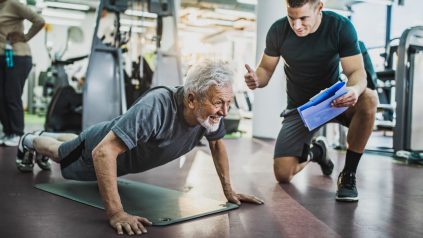Today’s workouts consist of high-tech resistance equipment, specialist gym-wear and top-of-the-range gadgets. But it hasn’t always been this way. In fact, personal trainers and fitness instructors owe a lot to their forefathers from centuries gone by.
It might come as a surprise to learn that the ‘workout’ dates all the way back to the Ancient Greek period, when strength and athleticism were essential attributes for warfare. It’s undergone a fair few transformations since then and is now a staple part of everyday life in modern society.
Let’s look at the history of the workout and it’s developed right up until the present day.
Made in the Mediterranean
Throughout history, there have been countless urban myths surrounding when exactly the workout started. However, humanity has relied on athletic prowess in some shape or form since virtually the beginning of time.
It appears to be between 4000 BC and the fall of the Roman Empire in 476 AD that people started taking part in intense physical training. The ancient Greeks and Romans would prepare young men for military service by giving them different strength-building exercises to complete, such as walking and running on uneven terrains, jumping, crawling, climbing, lifting and carrying, as well as throwing and catching.
Around this period, sports like boxing and wrestling – tests of strength, balance and endurance – also came to the fore. Legendary 6th century BC wrestler Milo of Croton from Southern Italy built up his physical strength by lifting a newborn calf over his shoulders and carrying it every day for four years – by which point it had allegedly grown into a bull!
The light after the Dark Ages
Between the 5th and 15th century, there doesn’t seem to have been a great deal of emphasis on physical training – at least not among the working classes. Because of feudalism, the dominant social system in medieval Europe, only noblemen and mercenaries did ‘proper exercise’, in preparation for military service. By contrast, peasants only got their exercise through hard labour and weren’t considered physically fit enough to fight in battle.
However, the Renaissance period from the 14th to 17th century inspired radically different attitudes towards health and fitness. Due to advances in anatomy, there was a much greater interest in health and the body. One of the figureheads of physical education around this time was the Italian tutor Vittorino da Feltre, who is playfully described as ‘the world’s first PE teacher’.
In 1420, Da Feltre integrated physical education into his lessons, for students of all ages, as he considered regular exercise the foundation of good health and mental stability. He would often participate in games and activities with his students and saw gymnastics as an art, rather than a precursor to military training.
A century on, in 1553, the Spaniard Cristobal Mendez wrote El Libro del Ejercicio Corporal y Sus Provechos – the world’s first book to focus on the benefits of exercise. In the book, Mendez recommends different drills for men, women and children, and there are chapters which give advice on how to prevent and recover from injuries. Just 16 years later, the Italian physician Mercuralis followed suit with his work De Arte Gymnastica, which even included illustrations on how to perform each exercise (see if you can tell what the below exercises are supposed to be? It’s definitely a far cry from the YouTube workout videos you see today!)
Rage against the machines
The Industrial Revolution saw a shift from manual production to machine-based processes. Workers were ‘on the move’ less than ever before and faced an increased risk of cardiovascular disease, cancer, and Type II Diabetes. Exercise became a leisure activity, rather than essential to well-being. People who were physically fit opted for careers as sportspeople rather than working in industry, due to the increasing number of opportunities made available to them. Being fit enough to fight for the homeland was seen as a matter of honour across Europe.
This is where gymnasiums and gymnastics became commonplace. In 1810, Frederich Jahn, widely referred to as the ‘Father of Gymnastics’, opened the world’s first Turnplatz, or open-air gymnasium, in Berlin. Jahn was a nationalist and pioneer of physical education who taught young gymnasts to see themselves as liberal figureheads for their ‘Fatherland’. As a result, the Turnverein (gymnastics association) movement spread rapidly across Germany.
Not to be outdone by the Germans, the Spanish came up with their own model of gymnastics (it turns out we owe a lot to our friends in mainland Europe for the modern day workout!). Military figure Francisco Amoros founded a military gymnastics schools in Madrid and Paris and later published A Guide to Physical, Gymnastic and Moral Education.
Reacting to trends in mainland Europe, the Swedes also developed principles of physical training, with Pehr Henrik Ling championing the use of calisthenics, breathing, and stretching exercises.
Jack the lad
By the start of the 20th century, the fitness industry was in full swing across the globe. In keeping with their forefathers, Western world leaders urged their citizens to be physically fit for the national security of their nations. Weights-based fitness equipment and dumbbells also came to the fore, in line with the ‘strongman’ approach to exercise. Bodybuilding had even become a phenomenon, with the world’s first bodybuilding contest taking place in 1901 at the Royal Albert Hall in London.
However, fitness experts or personal trainers as we know them today still didn’t yet exist. That was, until Jack LaLanne burst onto the scene. Hailing from San Fransisco, LaLanne is often labelled the ‘Godfather of Fitness’ – but in his younger life he was a self-confessed ‘sugarholic’ with a junk food diet. It was only after attending a nutrition lecture that he ditched the sweets and began working out on a regular basis.
LaLanne opened America’s first ever fitness club in Oakland, California in 1936. It was here that he offered supervised weight and exercise training to customers and gave nutritional advice, kickstarting the concept of the ‘personal trainer’. His main objective was to encourage his clients to improve their overall health. LaLanne’s famous quotes on nutrition include: “If man made it, don’t eat it” and “If it tastes good, spit it out”. When he was 21, Arnold Schwarzenegger challenged LaLalanne to a push-up and chin-up challenge – only to lose convincingly to the 54-year-old! Schwarzenegger later said: “That LaLanne’s an animal!”.
During his illustrious career, LaLanne is credited with inventing the pulley and leg extension devices and the Smith machine, all of which we see in gyms today. He also popularised the ‘jumping Jack’ exercise, by performing it regularly on his fitness TV programme The Jack LaLanne Show, which ran for over 30 years.
What next?
In the 1970’s, weight training became universal, following the release of the bodybuilding movie Pumping Iron and the subsequent popularity of Arnold Schwarzenegger. By the 1980’s, personal training had become a great way to make a living, thanks in no small part to LaLanne’s influence.
We have since seen the rise of celebrity personal trainers who have carved out illustrious careers for themselves by offering personal training at local health clubs and filming their workouts to be released on DVD and online.
The rise of social media and YouTube has undoubtedly accelerated the global boom of the workout, with millions of people watching and practicing exercise drills. To coincide with busy working schedules and today’s ‘on-the-go’ culture, these workouts can be performed anywhere at any time, with or without equipment.
Hopefully, you’ve now got a real insight into the history and development of the workout. However, should any of your clients suffer illness or injury resulting from one of your modern workouts, it’s essential that you protect yourself with the right insurance.
Insure4Sport offers a range of flexible sports insurance policies for fitness instructors and personal trainers, including Public Liability, Professional Indemnity, Personal Accident, Loss of Earnings, and many more. So what are you waiting for? Get an instant online quote today and discover how affordable peace of mind can be.







Leave a Reply